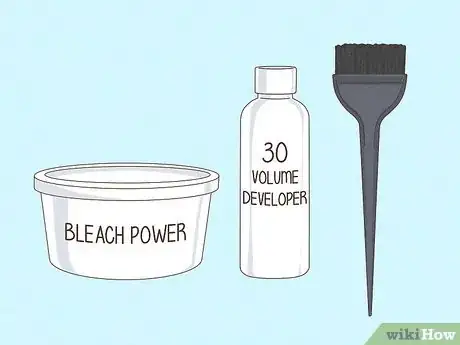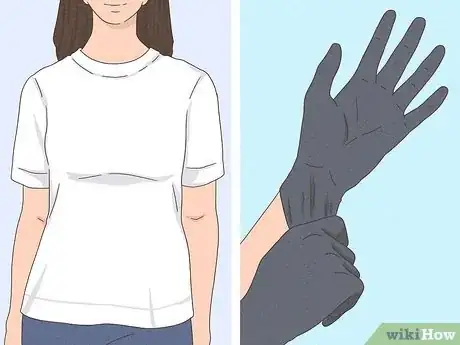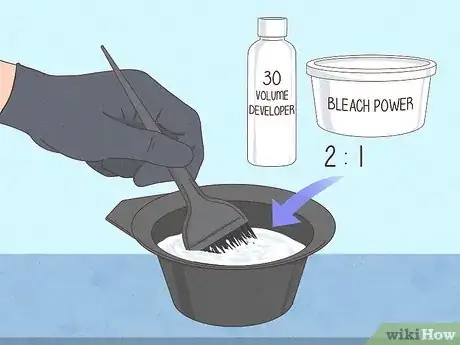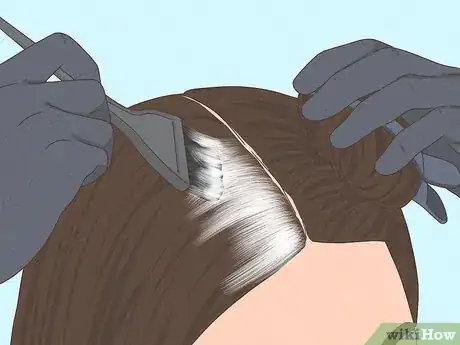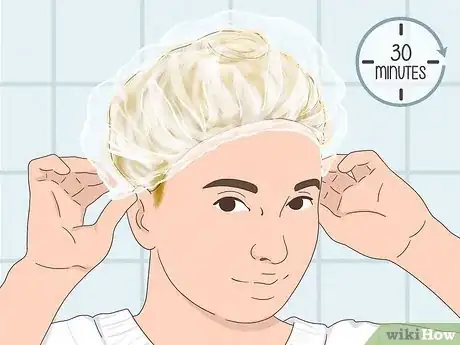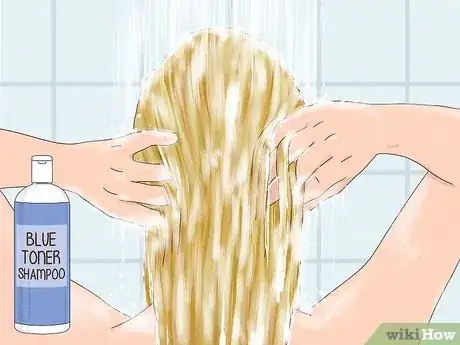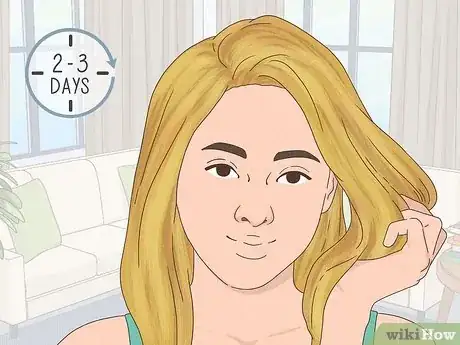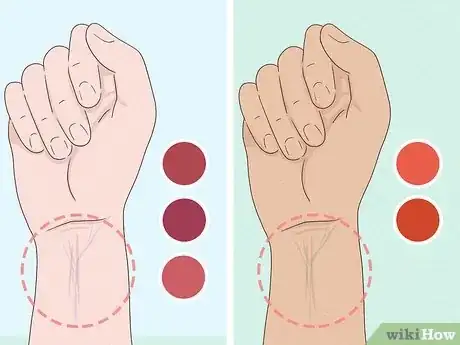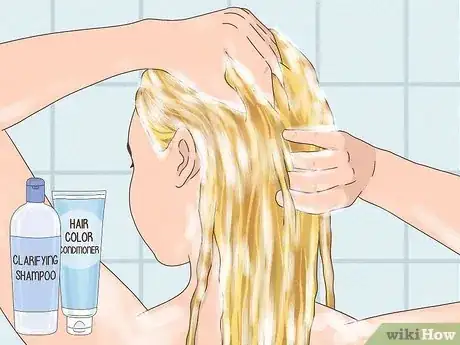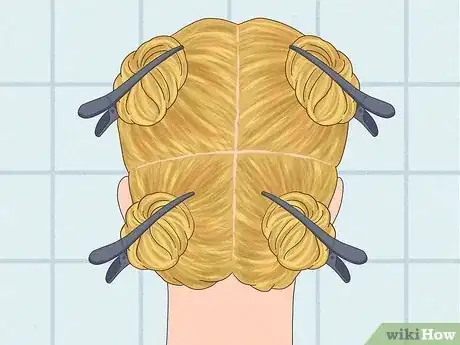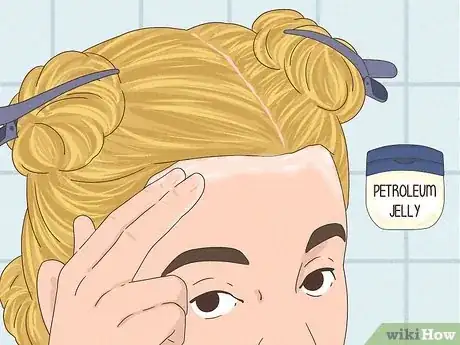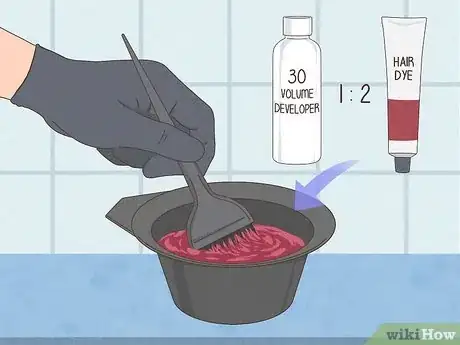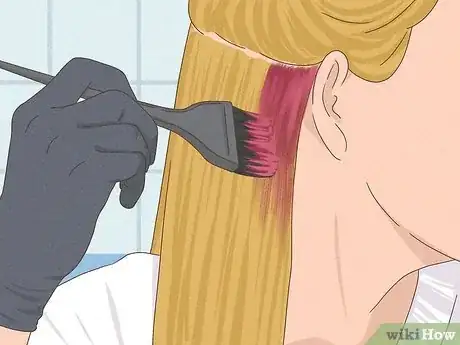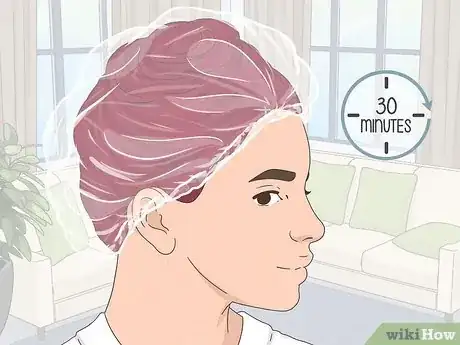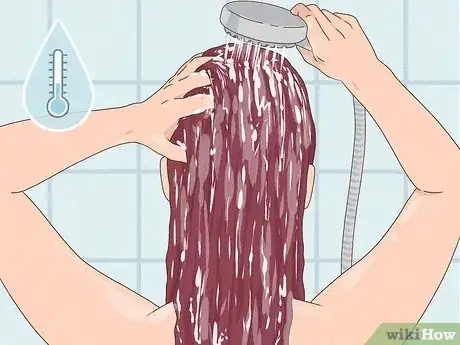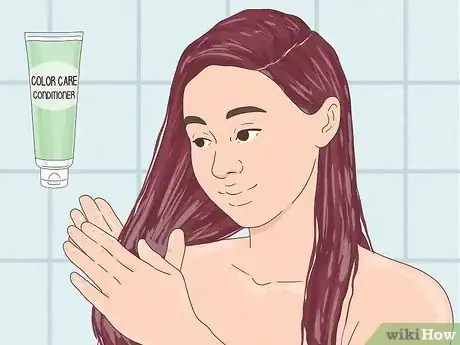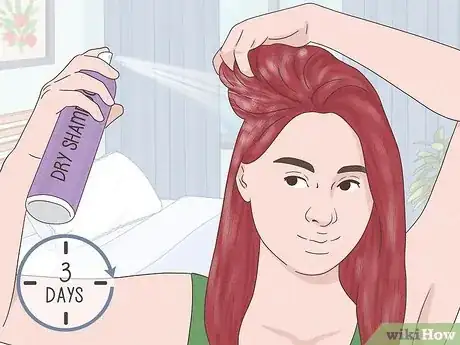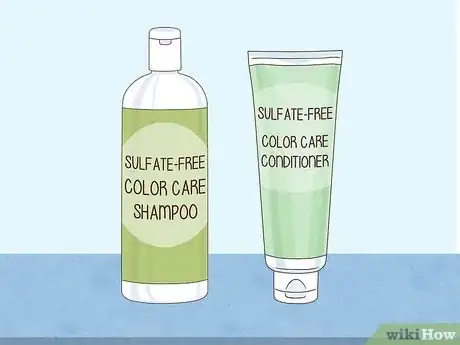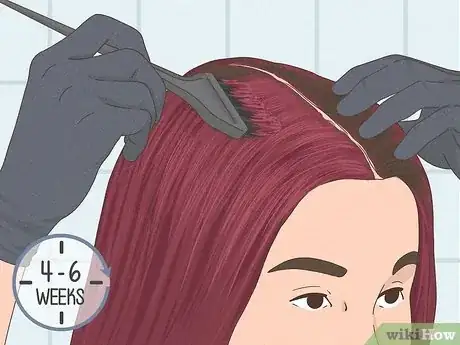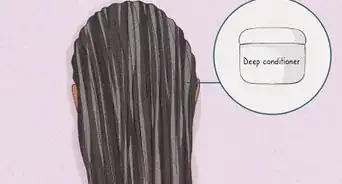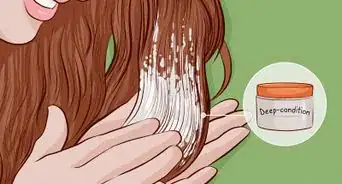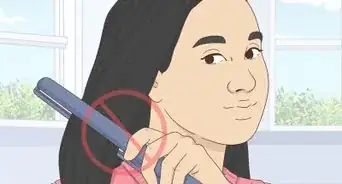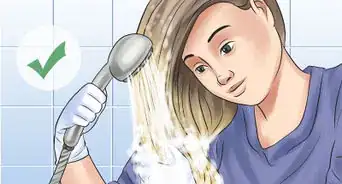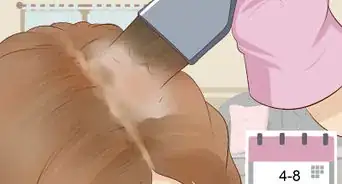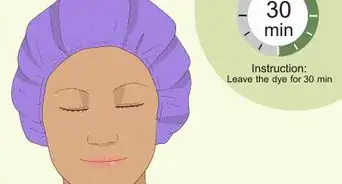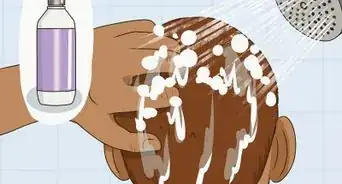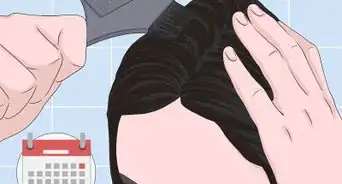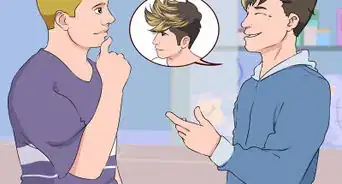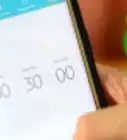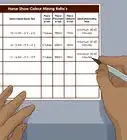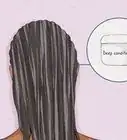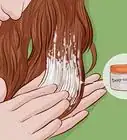This article was written by Karen Leight and by wikiHow staff writer, Dan Hickey. Karen Leight is a Professional Hair Stylist and the Owner of Karen Renee Hair, a private salon suite inside the Salon Republic Hollywood in Los Angeles, California. With over 12 years of experience, Karen is a licensed cosmetologist specializing in hair color, balayage technique, and women’s and men’s precision haircuts.
There are 12 references cited in this article, which can be found at the bottom of the page.
This article has been viewed 11,365 times.
Red hair is all the rage these days, but is it possible to get a natural looking shade at home if you have dark brown hair? Absolutely! If you have virgin (undyed) hair, you can use store-bought dye to lift (lighten) and color your hair without bleaching. If your hair is very dark or already colored, you can still get a vibrant, beautiful red by bleaching your hair first. We’ve put together a complete guide to turning your brunette locks red, including how to bleach your hair and maintain your new rockin’ red. If you’re ready to start turning heads with your luscious red locks, read on!
This article is based on an interview with our professional hair stylist, Karen Leight, owner of Karen Renee Hair. Check out the full interview here.
Steps
Bleaching Very Dark or Colored Hair
-
1Choose a bleaching kit with a 30- or 40-volume developer to lift dark color. A 40-volume developer will lift your hair up to 8 levels of color (from near black to dark blonde) in one session. This is great if your desired red color is bright, coppery, or blondish. To get the truest-to-shade red when you color, bleach your hair to a pale yellow color.[1]
- For darker or brownish red, use a 20-volume developer (most store-bought bleaching kits come with this strength). This lightens your hair 2 to 3 shades.
- If you want a reddish tint to your natural shade of brown, you don’t need to bleach at all.[2] If your hair is already colored, though, bleaching is a must.
- Follow the instructions on your bleaching kit carefully. 30- and 40-volume developers can cause scalp irritation or burns if misused or left on too long.
-
2Put on some old clothes and protective gloves. There’s always the chance you’ll drip some bleach onto your clothes, so wear something you don’t mind getting stained, like an old t-shirt. Wrap an old towel around your neck as well. Wear some rubber gloves to protect your hands from the bleaching product.[3]
- Bleach your hair in a room with good ventilation.
- Remove any bathroom rugs or mats to protect them from accidental bleach spills and drips.
Advertisement -
3Part your hair into 4 equal sections. Use your fingers or a rat-tail comb to divide your hair into 4 sections to evenly distribute the bleaching product. Secure each section of hair with a clip.[4]
-
4Mix the bleaching product according to the instructions. Directions vary, but usually you’ll mix 2 parts developer with 1 part bleach. Mix until the bleach is fairly runny, making sure there aren’t any lumps in the final product.[5]
- Mix the bleach and developer in a plastic bowl with your applicator brush (some bleaching kits come with a bowl and stirrers to use).
-
5Apply the bleach to your hair in small sections or strands. Use an applicator brush to paint the bleach into your hair, starting at the back of your head and moving forward. Start 1 in (2.5 cm) from your scalp and work down each section, making sure the bleach evenly and thoroughly coats each section of hair (front and back).[6]
- Bleach your roots last since they don’t take as long to process as the ends.
-
6Cover your hair and wait about 30 minutes. Use a processing or shower cap to cover your hair while the bleach does its work, keeping an eye on how your color is lifting while you wait. Check the instructions on the bleach for the exact amount of time you should wait.[7]
-
7Rinse and wash your hair thoroughly. Once your time is up, rinse out the bleach with cool water and wash it with a blue toner or purple shampoo to prevent a brassy or orange color from forming. To restore moisture, do a deep conditioning treatment too.[8]
- Washing and conditioning your hair reduces brassiness and ensures your red dye will come out true-to-shade.
-
8Wait 2 to 3 days before dyeing your hair red. Your hair needs time to recover between treatments, so allow it to rest for at least 2 days before you jump in with color. Try not to shampoo again until right before your dyeing session.[9]
Coloring Your Hair Red
-
1Choose a shade of red that flatters your skin tone for a natural look. If you have cool undertones (your skin tone is pink or pale and the veins in your wrist look blue), opt for cool, dark, or ashy reds. For warm undertones (your skin tone is tan or olive and your wrist veins look green), go for a bright or golden red.[10]
- If you have neutral undertones (a mix of cool and warm), you can pull off almost any kind of red!
- Follow the “2 shade rule”—pick a color at least 2 shades lighter or darker than your skin tone to avoid looking washed out.[11]
- Choose permanent color for long lasting red, or demi-permanent to experiment with color for just a few weeks.
-
2Shampoo and condition your hair before coloring. Use a clarifying shampoo to remove buildup on your hair and scalp. This will help the dye absorb better and make the coverage more even. Wait for you hair to be dry or slightly damp before you go in with the dye.[12]
-
3Separate your hair into 4 sections. Once hair is clean and dry (or almost dry), part it into sections with your fingers or a rat-tail comb. Hold each section in place with a clip.[13]
- Dyeing in sections helps the process go smoothly and makes it easier to reach all parts of your hair evenly.
-
4Spread petroleum jelly around your hairline. Use your fingers to rub a thin layer of petroleum jelly around all parts of your hairline, especially your forehead. This will keep the dye from staining your skin if it drips down onto your face or neck.[14]
-
5Mix your red hair dye with a developer. Follow the exact instructions on your dyeing kit. In most cases, you’ll combine developer and color in a 1:1 or 1:2 ratio. Some dye kits include a developer, but you may have to buy some separately.[15]
- Mix the developer and color in a plastic bowl with your applicator brush (some coloring kits come with mixing supplies).
- For permanent color, use a moderate 20- or 30-volume developer. Remember, stronger developer means lighter color.
-
6Apply the dye to your hair in small sections or strands. Use an applicator brush and paint the dye onto sections of your hair, starting 1 in (2.5 cm) from the scalp and working downward. Begin at the back of your head and work forward, making sure each section of your hair is saturated with dye (on top and underneath).[16]
- Go back and color your roots halfway through the overall processing time (it doesn’t take as long for the dye to take hold at the roots).
- The exact directions will vary by product, so be sure to double check your specific dye’s instructions.
-
7Leave the dye in your hair for 30 to 45 minutes. Put on a shower or processing cap to protect your hair and wait the recommended time according to the instructions on your dye. In most cases, that’s around 30 minutes or so.[17]
-
8Rinse your hair thoroughly with cool water. After your time’s up, rinse away all of the dye from your hair. Wash away the petroleum jelly around your hairline at this time as well.[18]
- Wait at least 3 days after you color your hair to shampoo it. This gives the color time to set and the cuticles time to seal.[19]
-
9Finish with a color-safe conditioner. After the dye is rinsed out, apply conditioner to seal the hair cuticles (the outermost layer of your strands of hair). Rinse again with cool water and blow or air dry your hair to see your ravishing new red![20]
Maintaining Red Hair
-
1Wait as long as possible to shampoo your freshly colored hair. Your hair might need as long as 3 days to let the cuticles fully close and seal in the color. Use dry shampoo in the meantime if your hair starts to look greasy.[21] After the first shampoo, aim to only wash your hair 2 or 3 times a week to prevent the color from fading.[22]
- When you start washing your hair again, use cold water (hot water will steam away the color, meaning your dye job won’t last as long).
- If your hair gets oily, try a scalp exfoliator or dry shampoo. It will remove some oil from your hair and keep it moisturized without eroding your color.
-
2Invest in sulfate-free shampoos and conditioners. Sulfates make artificial hair color fade away even faster than normal. Look for products that are safe for colored hair that don’t contain sulfates, salts, parabens, or artificial colorants. In general, colored hair is safest with the purest, simplest shampoos.[23]
- Use a blue color-balancing shampoo, conditioner, and a hair mask for colored hair to prevent cooler shades of red from turning orange or brassy.
-
3Use a heat protectant before styling your hair with hot tools. This will keep your hair color looking bright, as well as prevent heat damage. Also consider heat protectant sprays with UV protection if you’re going to be spending lots of time in the sun.[24]
- Use low heat settings on curlers and straighteners when styling your hair.[25]
-
4Touch up your color every 4 to 6 weeks. Red is more prone to fading than other colors, so refreshers are necessary. Use the same dye you applied initially. Instead of the full 30 or so minutes of sitting, simply run the color through your hair and leave it for 15 to 20 minutes.[26]
- Buy multiple boxes of color when you first dye your hair so you’re stocked and ready for touch ups anytime.
Warnings
- Always follow the directions for your specific hair dye, bleach, or other products for the best, most natural-looking results.⧼thumbs_response⧽
- Bleaching and dyeing isn’t recommended for fragile, compromised, or overly colored hair.⧼thumbs_response⧽
References
- ↑ https://www.wunderkult.com/hair-color-levels-and-different-volumes-of-developers/
- ↑ https://www.empire.edu/blog/beauty-tips/do-you-have-to-bleach-hair-prior-to-dyeing-it
- ↑ https://manofmany.com/fashion/mens-hairstyles/how-to-bleach-your-hair
- ↑ https://manofmany.com/fashion/mens-hairstyles/how-to-bleach-your-hair
- ↑ https://manofmany.com/fashion/mens-hairstyles/how-to-bleach-your-hair
- ↑ https://www.curlcentric.com/how-to-dye-brown-hair-red/#bleaching_and_toning_instructions
- ↑ https://manofmany.com/fashion/mens-hairstyles/how-to-bleach-your-hair
- ↑ https://www.curlcentric.com/how-to-dye-brown-hair-red/#bleaching_and_toning_instructions
- ↑ https://www.curlcentric.com/how-to-dye-brown-hair-red/
- ↑ https://www.colouredhaircare.com/auburn-hair-how-to-get-the-look-at-home/#Can-brunettes-go-auburn
- ↑ https://www.newbeauty.com/two-shade-color/
- ↑ https://www.colouredhaircare.com/auburn-hair-how-to-get-the-look-at-home/#Can-brunettes-go-auburn
- ↑ https://manofmany.com/fashion/mens-hairstyles/how-to-bleach-your-hair
- ↑ https://www.curlcentric.com/how-to-dye-brown-hair-red/
- ↑ https://www.curlcentric.com/how-to-dye-brown-hair-red/
- ↑ https://www.glamour.com/story/how-to-color-your-hair-at-home
- ↑ https://www.colouredhaircare.com/auburn-hair-how-to-get-the-look-at-home/#Can-brunettes-go-auburn
- ↑ https://www.colouredhaircare.com/auburn-hair-how-to-get-the-look-at-home/#Can-brunettes-go-auburn
- ↑ https://www.newbeauty.com/things-you-shouldnt-do-after-coloring-your-hair/3
- ↑ https://www.curlcentric.com/how-to-dye-brown-hair-red/
- ↑ https://www.empire.edu/blog/beauty-tips/do-you-have-to-bleach-hair-prior-to-dyeing-it
- ↑ https://www.empire.edu/blog/cosmetology-how-tos/8-commonly-asked-questions-about-coloring-your-hair
- ↑ https://www.empire.edu/blog/beauty-tips/do-you-have-to-bleach-hair-prior-to-dyeing-it
- ↑ https://www.colouredhaircare.com/auburn-hair-how-to-get-the-look-at-home/#Can-brunettes-go-auburn
- ↑ https://www.empire.edu/blog/beauty-tips/do-you-have-to-bleach-hair-prior-to-dyeing-it
- ↑ https://youprobablyneedahaircut.com/how-often-should-you-dye-your-hair/#How_Often_Should_You_Dye_Your_Hair
